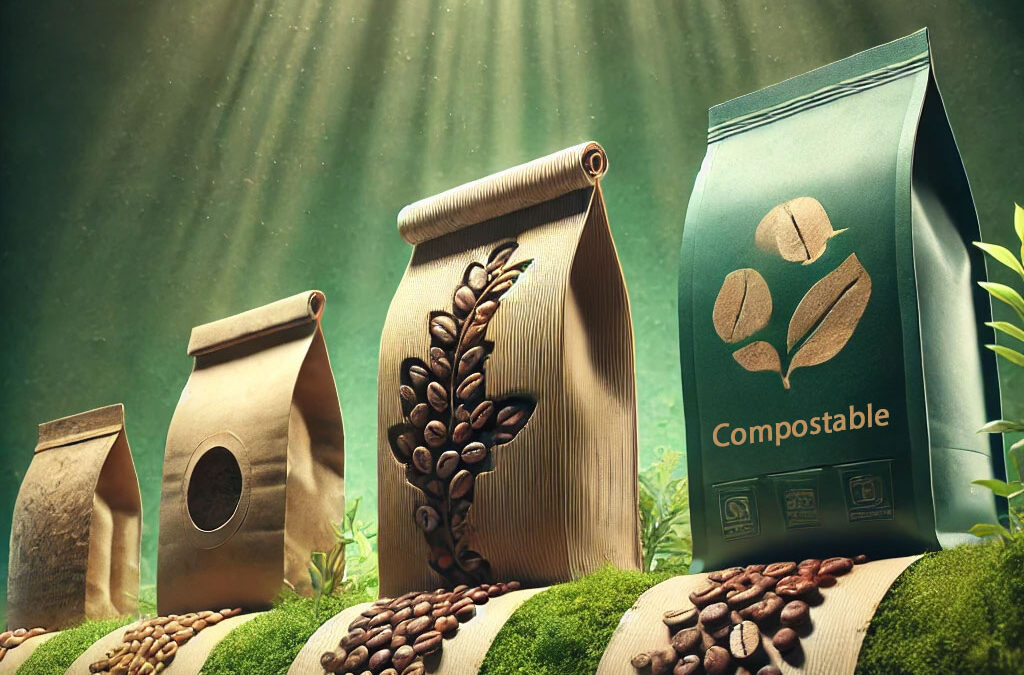This shift is more than just a trend—it’s a necessary response to growing concerns about waste, pollution, and sustainability. In this post, we’ll explore how coffee packaging has evolved over time, the benefits of compostable options, and what the future holds for sustainable coffee packaging.
The Early Days: Kraft Paper Packaging
Before eco-conscious materials became the norm, coffee was often packaged in kraft paper bags. These bags, made from natural brown paper, were an improvement over plastic because they were biodegradable and relatively easy to recycle. However, they lacked essential properties like moisture resistance and durability, which meant they didn’t keep coffee fresh for long.
Downsides of Kraft Paper Bags:
- Limited freshness – Coffee beans can lose their flavor quickly due to air exposure.
- Lack of durability – Kraft bags can tear or wear down easily.
- Not fully sustainable – While biodegradable, they often contained plastic linings to improve functionality, making them harder to recycle.
As the demand for high-quality, fresh coffee grew, so did the need for better packaging solutions.
The Rise of Multi-Layer Packaging
To address the freshness issue, coffee brands started using multi-layer packaging. These bags typically combined kraft paper with aluminum or plastic linings to create a barrier against moisture, air, and light. This innovation helped extend shelf life and maintain coffee quality, but it came at an environmental cost.
Environmental Drawbacks of Multi-Layer Packaging:
- Difficult to recycle – The combination of materials made separation and recycling nearly impossible.
- Plastic waste concerns – Many of these packages ended up in landfills, contributing to pollution.
- High energy production – Manufacturing these bags required more energy than traditional kraft paper.
While multi-layer packaging improved coffee freshness, it was clear that a more sustainable solution was needed.
The Shift Toward Compostable Packaging
As sustainability became a bigger priority, brands began experimenting with compostable packaging—bags designed to break down naturally without harming the environment. Unlike traditional plastic-lined options, compostable coffee bags use plant-based materials like cornstarch, sugarcane, or wood pulp to create eco-friendly solutions.
Benefits of Compostable Coffee Packaging:
- Completely biodegradable – Breaks down naturally without leaving harmful residues.
- Plant-based materials – Reduces reliance on fossil fuels and plastic production.
- Sustains coffee freshness – Innovative barrier technology helps keep coffee beans flavorful.
Many brands are now embracing compostable packaging as an industry standard, making it easier for consumers to enjoy their coffee without guilt.

The Future of Sustainable Coffee Packaging
Looking ahead, the coffee industry continues to innovate, with some companies developing fully reusable or refillable coffee containers. Advances in technology are also making compostable materials even more effective, ensuring that they can maintain freshness while remaining environmentally friendly.
What’s Next for Coffee Packaging?
- Reusable coffee bags and refill stations – Encouraging waste-free shopping habits.
- Biodegradable ink and adhesives – Making every part of packaging sustainable.
- Improved composting facilities – Ensuring that compostable bags break down efficiently.
With more brands committing to sustainability, the future of coffee packaging is shaping up to be greener than ever.
Closing Thoughts: Sipping Sustainably for a Better Tomorrow
The transition from kraft paper to compostable coffee packaging marks a major step toward a more sustainable future. As coffee lovers, we have the power to support brands that prioritize eco-friendly solutions, helping to reduce waste and promote a cleaner planet. Whether it’s through compostable bags, refill stations, or innovative materials, one thing is clear—sustainability in coffee packaging isn’t just a passing trend; it’s the future.
Next time you grab a bag of your favorite coffee, take a moment to consider its packaging. The choices we make today can lead to a greener, more sustainable world for coffee drinkers everywhere.

